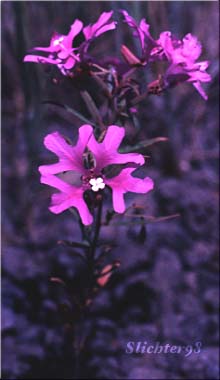 The photo at right shows Clarkia
pulchella from the Steens Mt North Loop Road.........6/27/97.
The photo at right shows Clarkia
pulchella from the Steens Mt North Loop Road.........6/27/97.
Other synonyms of elkhorns Clarkia include beautiful Clarkia, ragged robbin, deer horn and pink fairies. It is an attractive annual wildflower with a simple to freely branched form. It may attain a height as great as 50 cm. The leaves are linear-lanceolate to spatulate, and are with entire to denticulate margins. The length of the leaves varies from 2 to 7 cm and the width from 2 to 10 mm. The lower leaves are nearly opposite while those of the upper stem are alternate.
The flower buds nod, and the petals are lavendar to rose-purple. The four striking petals are 3-lobed, with the middle lobe the widest (See photos.). The base of the petal narrows to a fairly narrow claw, with a pair of opposite, short, divergent, blunt teeth near the base. Each petal is 1.5-3 cm long. Each of the 4 sepals is 8-15 mm long. The sepals may each be indvidually reflexed downward, but they may also be attached at the tip and turned downwards to one side of the flower. The floral tube is 2.5-4 mm long. Eight stamens are present, but only the outer 4 are pollen-bearing. The 4 broad stigma lobes are spreading, spatulate to rotund-obovate in shape, and each is 1-3 mm long. The capsule is cylindric in shape, quadrangular in cross-section, and measures from 1.5-2.5 cm long.
Ragged robbin is a beautiful wildflower which can be used in dryland gardens fairly successfully. I'm seeing a few nurserys which carrry this species as a small annual. With a little bit of water, the plants become many branched, mounded in shape, and covered with numerous blossoms. The bloom period in the garden can last several weeks to a month or so. Seeds can also be broadcast late in fall, or at latest soon after snow melt in prairie habitats or atop more open, sandy to rocky soils.
Elkhorns Clarkia is found in grasslands and often in combination with sagebrush or rabbitbrush. It may also be found under ponderosa pine in open forests and is most common in the lowlands below 1500 meters of elevation.
Elkhorns Clarkia is found from southern British Columbia, south along the Columbia River and along the east slope of the Cascades to central Oregon, and eastward to southeastern Oregon and through southern Idaho to western Montana.